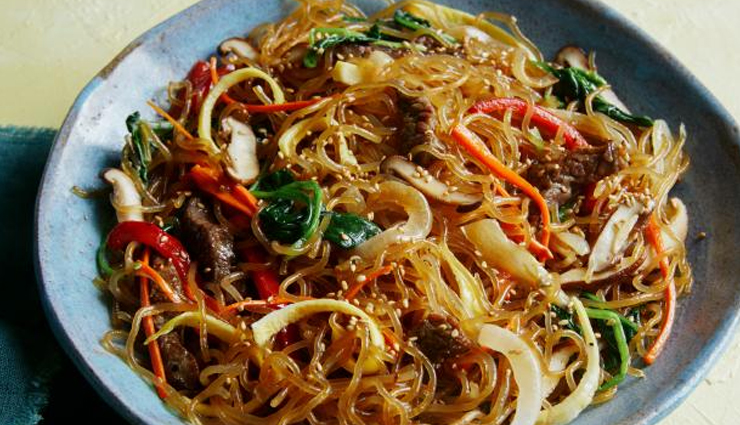6 Delicious South Korean Food You Must Try
By: Kratika Maheshwari Thu, 06 Jan 2022 6:05:22

People say that you need to experience a country’s food to truly understand its culture. This is particularly true about South Korean food. With their bold flavours and unique tastes, Korean dishes have become a global sensation over the past few years. While you will get Korean food in most places around the world, it’s always at its most authentic when you try it locally.
Korean food has been greatly influenced by the Japanese who colonised the region for a time, and by the Chinese, but has since evolved into something quite distinct from the various other cuisines of the region. While rice remains a staple, as do chopsticks (often made with metal though, rather than wood), the food is made unique by the side dishes accompanying it, such as the now-famous kimchi. Beef is a very popular delicacy and is a common ingredient in the equally popular and ubiquitous Korean barbeques.
Korean cuisine may seem complicated, especially with the innumerable side dishes, but it need not be so. Korean dishes often feature a well-balanced mix of meat, veggies, rice, and spice. So, if you’re wondering what to eat in Korea, we’ve got you covered.

# Spicy And Salty Kimchi
One of the most famous of all Korean dishes, kimchi is an institution in itself. It dates back to the era of the Three Kingdoms of Korea (37 BCE‒7 CE) and was an ideal method to preserve the lifespan of the vegetables. This side dish is made with fermented cabbage, along with various other vegetables, all seasoned with onion, garlic, ginger and chilli. Spicy, salty, and a little sour, it is served with almost every meal of the day. While you will find kimchi in a lot of supermarkets today, try to get it at an authentic Korean restaurant for a more fresh taste. It’s an excellent option for vegetarians/vegans.

# Hobakjuk
Juk refers to any kind of porridge in Korean, and this version is made with sweet pumpkin and glutinous rice flour. Smooth and naturally sweet Korean cheese pumpkins called cheongdung-hobak are generally used to make this popular breakfast dish. Hobakjuk can either be eaten hot or cold and is also served to the unwell or elderly. This is a popular autumn or winter dish that can be found throughout the country, though you’ll find the most variety in Seoul. It’s usually both vegan and gluten-free (though other variations may exist).

# Bibimbap
This traditional Korean food has existed for centuries and is said to have originated with early rural Koreans mixing leftovers in a bowl when they didn’t have time for a formal meal. Bibimbap literally means “mixed rice”, and this Korean dish includes a variety of ingredients. Everything from namul (seasoned and sautéed vegetables), to slices of meat, soy sauce, fried eggs, and gochujang (red chilli paste) can be used. While the ingredients may vary, it is important to have at least five colours (black, white, red/orange, yellow, and green—each with a specific symbolic meaning) in the bowl; so look out for this when you try this dish! The cities of Jeonju, Jinju and Tongyeong are especially famous for their version of bibimbap.

# Grilled Samgyeopsal
Literally meaning “three-layered meat” samgyeobsal, or grilled pork belly, is a type of gui (grilled dish) found in most Korean barbeques. The meat is usually neither marinated or seasoned, but is accompanied by leafy vegetables, pickles, and dipping sauces. It is among the most popular Korean meat dishes along with galbi (marinated beef or pork short ribs) and bulgolgi (shaved tenderloin). Every year, 3 March is celebrated as “Samgyeopsal Day” in South Korea and it’s the best time to try all kinds of variations of this dish at restaurants across the country.

# Japchae
Japchae originates from Korean royal cuisine once served in palaces and courts. It was first made in the early 17th century for King Gwanghaegun, and slowly adopted by the common people. This sweet and savoury dish of glass noodles (called dangmyeon) and vegetables, is stir-fried with meat and soy sauce and is extremely popular. It’s commonly found at celebrations and holidays (as it’s easy to prepare in bulk), so try to wrangle an invitation to try some when you visit! Japchae is often served as a side dish, but other ingredients, such as mushrooms and extra beef can be added to it to make it a more substantial meal.

# Cold Bingsu
This Korean dish dates back to the Joseon Dynasty (1392-1897) when there was a government office in charge of sharing the ice with fellow officials to mix with fruit. Bingsu, or patbingsu, has long been a popular way to combat hot Korean summers. Sweetened shaved ice is topped with anything from fruits to green tea, along with condensed milk and sweet red bean paste. You must try patbingsu at one of the many fast-food restaurants and cafes in South Korea.





